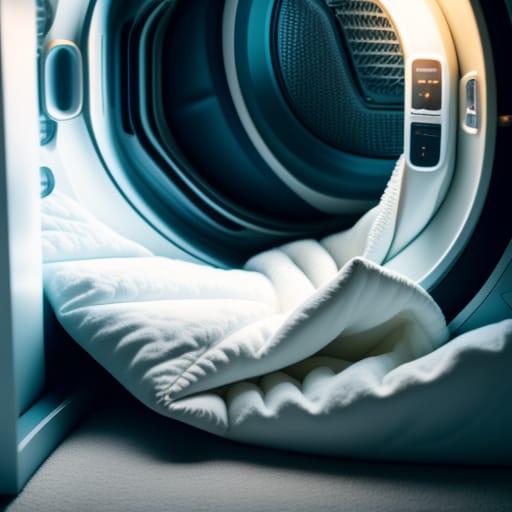Drying a comforter can be a daunting task if you’ve never done it before. A comforter is a large, fluffy blanket that can take a long time to dry and requires special care to avoid damage. Follow this beginner’s guide to learn the proper way to dry a comforter in the dryer from start to finish. With these tips and techniques, you’ll keep your comforter fresh, fluffy, and free of mildew.
An Introduction to Drying Down Comforters
Proper drying is essential for keeping comforters clean, cozy, and long-lasting. When a comforter gets wet, it needs to be dried thoroughly to prevent musty odors and growth of mold or mildew. Drying it quickly also helps restore the fluffiness.
Here’s an overview of why proper drying matters and the key steps involved:
- Prevent odors and bacteria: Drying a comforter fully prevents dampness that allows odor-causing bacteria to grow.
- Regain fluffiness: The drying process helps fluff up the comforter filling and restore puffiness.
- Prolong lifespan: Quick drying helps prevent damage from moisture. This extends the comforter’s usable life.
- Follow care instructions: Always check tag guidelines to avoid shrinkage or harm to the fabric.
- Use the right dryer settings: Choosing suitable temperature, cycle, and duration are key for effective drying.
- Try special techniques: Using dryer balls, tennis balls, or air drying can speed up drying time.
Follow the guidelines below to make sure your comforter dries properly using your home dryer.
Preparing the Comforter for Drying
Before tossing your comforter in the dryer, there are a few key steps:
Check the Care Label
Look at the sewn-in tag for drying instructions. This will indicate the maximum recommended temperature and if any special drying cycles are needed.
- For down comforters, low or delicate settings are best. High heat can damage down.
- Polyester fills can handle medium to high heat.
- Comforters with wool, silk, or rayon require a low, delicate dryer setting.
Remove Stains, Odors, or Pet Hair
Treat any visible stains or odors first. Use a stain remover formulated for the fabric. Check for pet hair or other debris and brush thoroughly before drying.
Use Dryer Balls
Add 2-3 dryer balls to help separate and fluff the comforter. Wool or plastic balls speed up drying.
Choosing the Right Dryer Settings
Choosing the best temperature and cycle for your comforter makes a big difference in proper drying and prevention of heat damage.
Dryer Size
Use the largest capacity dryer available with plenty of free space for the comforter to tumble freely. This allows air to circulate and dry the comforter evenly.
Temperature Setting
Refer to your care label for the maximum recommended heat setting. Some guidelines:
- Cotton: Medium or high heat
- Down/feathers – Low to medium heat only
- Synthetic fills: Medium heat
- Delicate fabrics like wool or silk: Low heat only
Cycle Selection
The optimal drying cycle depends on your comforter fabric:
- Everyday cotton comforters: Cotton/normal cycle
- Delicate comforters: Delicates or low heat cycle
- Bulky comforters: Bulky/bedding cycle to dry large items
Choose the timed drying option for better control over the process.
Techniques for Faster Comforter Drying
It can take hours to dry a large comforter. Try these tricks to speed up the process:
Show Image
Air Drying
Hang-dry your comforter on an outdoor clothesline or indoor drying rack. This prevents heat damage but takes longer.
Dry Towels
Throw 1-2 large dry bath towels in the dryer with the comforter. These will help absorb moisture.
Dryer Balls or Tennis Balls
Adding 2-3 rubber dryer balls or clean tennis balls will help separate and fluff the filling.
Tips for More Efficient Comforter Drying
Proper technique goes a long way in drying your comforter efficiently. Here are some useful tips:
- Shake out the comforter before drying to separate the inner filling. This allows air to circulate better.
- Periodically pause the dryer to rearrange and fluff up the comforter for even drying.
- Clean the dryer lint filter frequently during the drying cycle to increase air flow.
- Use the highest spin cycle on your washer to extract excess water before drying.
Adding the occasional dry towel or dryer balls will also help speed things up.
Common Comforter Drying Mistakes to Avoid
It’s easy to make mistakes that damage your comforter or prevent thorough drying. Watch out for these issues:
Overloading the Dryer
Don’t cram an oversized comforter into a small dryer. Overcrowding prevents proper tumbling and air circulation for quick, even drying.
Excessive Heat
High temperatures can scorch delicate fabrics like wool or silk. Refer to the care label and use the lowest recommended setting.
Over-Drying
Don’t run the dry cycle much longer than required. This can damage fabrics and cause the filling to clump.
Forgetting Dryer Balls
Dryer balls or clean tennis balls help separate filling and speed up drying time. Don’t skip them!

Estimating Comforter Dry Times
Drying a bulky comforter takes patience – anywhere from 2 to 6 hours depending on the size and fabric.
Typical Comforter Dry Times
| Comforter Type | Approximate Dry Time |
|---|---|
| Cotton Shell, Poly Fill | 3-4 hours |
| Down-filled | 4-6 hours |
| Synthetic Fill | 2-3 hours |
| Wool or Silk | 4-5 hours, delicate cycle |
Check on your comforter’s progress every 30-60 minutes after the first 2 hours. Look for dry edges andsurfaces. When there’s no moisture inside, it’s done.
Post-Drying Comforter Care
Once your comforter is dry, there are a couple extra steps:
- Allow the comforter to completely cool before using or making the bed.
- Give it a final fluff and shake out to restore puffiness.
- Avoid tightly folding down comforters long-term. Instead roll or store loosely in a breathable bag.
- Steam or lightly spray with water and tumble dry on air fluff cycle to freshen down comforters.
Proper post-drying maintenance will keep your comforter in top condition after laundering.
Special Considerations for Different Comforter Fabrics
Not all comforters can be dried the same way. Here are tips for various comforter types:
Down-Filled Comforters
- Use low heat only to prevent damage to delicate down.
- Add a couple of clean tennis balls for fluffing action.
- Air drying is recommended to maximize fluffiness.
Wool or Silk Comforters
- Only use a low, delicate heat setting.
- Roll up loosely in a towel to absorb moisture, changing towels as needed.
- Air dry flat if possible to prevent stretching wool or silk fabric.
Polyester or Synthetic Filled Comforters
- Medium heat is acceptable, but avoid high heat.
- Dry with a couple of wool or rubber dryer balls for best fluffing.
- Can machine dry completely but air drying also works.
Keeping Comforters Fresh and Clean
To maximize the life of your comforter and keep it sanitary, remember:
- Wash comforters 2-3 times per year in cold water on a gentle cycle.
- Store folded comforters in breathable cotton cases or bags.
- Wash the comforter cover every 2-3 weeks for a fresh bed.
- Spot clean as needed between washes for spills or stains.
- Consider professional comforter cleaning services once a year for a deep clean.
- Replace the comforter every 5-8 years for maximum comfort and freshness.
With proper drying and regular cleaning, your comforter will provide cozy warmth for years. Follow these beginner tips for handling this useful bedding essential.

Conclusion: Your Guide to Drying Down Comforters is Complete!
Drying that favorite fluffy comforter may seem intimidating, but it doesn’t have to be. With this complete beginner’s guide, you now have the key techniques, tips, and steps to properly dry a comforter at home.
By following care label instructions, choosing suitable heat and dryer settings, using special drying tools like balls and towels, and taking time to complete the process, you can keep a comforter fresh and damage-free for the long haul.
Refer back to this article anytime your comforter needs refreshed. And don’t be afraid to use professional laundering for occasional deep cleaning and sanitizing. With the right maintenance, your comforter will remain a cozy staple of your well-made bed for years of restful sleep.
Frequently Asked Questions
What temperature should I use to dry my down comforter?
Use a low heat setting to safely dry a down-filled comforter without damaging the delicate down material. High heat can cause the down to singe or become brittle. Refer to the care label for the maximum recommended temperature.
How can I speed up comforter drying time?
Try adding a couple of dry towels or dryer balls to help absorb moisture and keep the down fill separated for faster drying. Periodically pause the dryer to rearrange and fluff the comforter for even drying.
How long does it take to dry a comforter?
Depending on the size and fabric, drying a comforter can take 2 to 6 hours. Bulkier down-filled comforters take longest at 4-6 hours on low heat. Check for dryness every 30-60 minutes after the first 2 hours.
Can I put my comforter in the dryer right after washing?
Yes, you can put your comforter in the dryer immediately after the washing cycle is complete. Use a high spin cycle on your washer to extract excess moisture first. Make sure to clean the dryer lint filter before drying.
Should I air dry or machine dry my comforter?
You can air dry comforters by hanging or laying flat, though this takes much longer than machine drying. For maximum fluffiness, air drying is recommended for down comforters. Machine drying works well for cotton and synthetic fills.
How often should I wash and dry my comforter?
Ideally, wash and dry your comforter 2-3 times per year for proper maintenance. Clean the cover every 2-3 weeks. For freshness between washes, spot clean stains and allow the comforter to air out occasionally.
What’s the best way to dry wool or silk comforters?
Use a low, delicate dryer setting for wool or silk comforters to prevent heat damage. Roll up loosely in towels while air drying to absorb moisture. Lay flat or hang to dry fully before using.








